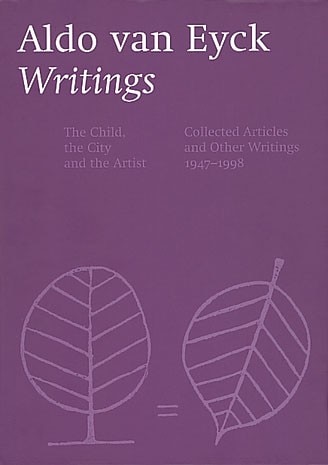Writings. The child, the city and the artist. Collected Articles and other writings 1947-1998, Aldo van Eyck, edited by Vincent Ligtelijn and Francis Strauven Sun, Amsterdam 2008 (pp. 980, s.i.p.)
This publication comprises two bound volumes and a slipcase, accompanied by a subdued and meticulous graphic design. The first volume contains a long, serious essay written by van Eyck in 1962 entitled “The Child, the City and the Artist”, which was circulated widely in the universities, particularly in the US, but never published. Focusing on time, imagination and the concept of place, relativity, symmetry and nature, it is the closest van Eyck ever came to writing a mini-theory or treatise. The second volume, roughly three times the length of the first, is an assortment of essays, articles, written pieces, interviews, speeches and letters dating from 1947-1998. Together they total approximately 900 pages, with many small pictures of designs and constructions, souvenir photos, scattered images and portraits. As a parenthesis, we might note the unfortunate absence of a proper monograph on the work of van Eyck the builder. The next best thing is Francis Strauven’s publication Aldo van Eyck. The Shape of Relativity (1998), although this is basically a ramified biography accompanied by an anthology of works. In his lifetime, van Eyck constructed his aura around his intellectual contribution rather than his albeit extraordinary architecture.
Van Eyck wrote very well and his pen remains as sharp as a scalpel. Indeed, many of his words are still amusing when re-read years later because they avoid all superficiality; they also lack the magniloquence and presumption that often distinguishes architects’ writings. Always with grace (although his attacks were sometimes extremely gory) and usually tinged with a good dose of humour, he simultaneously addressed the worlds of ideas and of things. To his mind, these two worlds are held together by man, who according to Van Eyck’s anthropological interpretation has had the same mind and body since time immemorial: man plays, moves, stops, laughs, cries, builds, loves and acts. How little man has changed over time remains the crux of his theory. For him, there was no homo modernus, nor even contemporaneity. Van Eyck did not even believe in the existence of architecture as image; he loved to argue and never allowed himself to be dazzled by things. His buildings never have a facade.
The many pages in the two volumes give a direct account of the reasons behind the crisis of post-World War II orthodox modernity. When seen from a different standpoint, these reasons generated the tired modernity of the last 20 years. A large number of multilingual people passed through the loose weave of Team 10, and many trends were born out of the discussions of those years. One realises the gravity of the loss, today, of opportunities for exchange, save in the rarest of cases. The overhead picture of a late Team 10 meeting held in 1974 in Van Eyck’s home in Loenen aan de Vecht is steeped in nostalgia. You can see De Carlo, the Smithsons, Ungers, Erskine, Candilis, Bakema and Pietilä. At first glance it seems so far removed in time as to have nothing to do with us, until you realise that all this was actually yesterday and that we ourselves are the long-lasting effects of it. To the publication’s credit, it is not academic and it flits between history, criticism and controversy. It is the type of book you can keep on your beside table, reading a few lines now and again to refresh your ideas. Volume two hosts a myriad of comments and literary stimuli, including the famous essays published in Forum (such as the one in 1962 on the Pueblos of the American Indians), as well as the accusatory anti-post-modern speech made at the Royal Institute of British Architects in 1981, when he was awarded the Gold Medal (“R.P.P. – Rats, Posts and Other Pests”), as well as the poetic literary drafts on chromatism, labyrinthine clarity, symmetry, synchrony and the analysis of form. Aldo certainly did not see architecture as a set of standards and regulations.
Sebastiano Brandolini Architect


